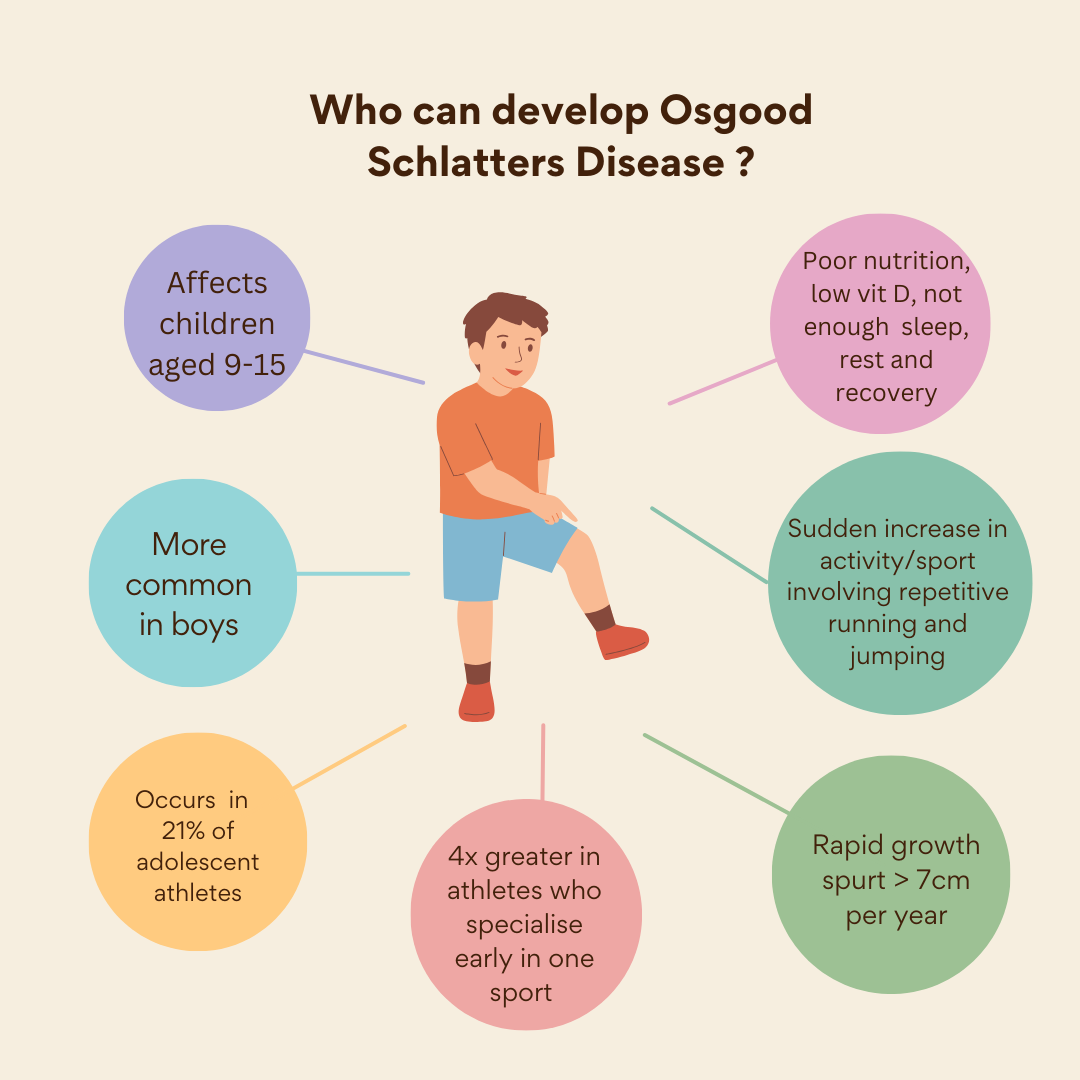Osgood Schlatters Disease



Osgood Schlatters Disease
What is it ?
Osgood Schlatters disease is a term used to describe pain that is in a very localised area just below the patella ( knee cap) on the shin bone where the patella tendon inserts (the tibial tuberosity).
The cause of Osgood Schlatters disease is not yet fully understood. It is most commonly seen in sporty adolescents between the ages of 9-15, more often in boys and 4 times more common in those athletes who have specialised early in 1 sport, but it can also occur in the non sporty population too.
It typically occurs in one knee but can sometimes occur in both.
Pain usually comes on gradually and is often aggravated by running 🏃 and jumping, but also squatting and kneeling.
The knee pain usually eases with rest.
During rapid growth spurts, especially in those children who have grown more than 7cm in a year, there is an increase in tension in the quadriceps muscles on the front of the thigh at its attachment to the shin bone at the tibial tuberosity.
In combination with a sudden spike in high intensity, repetitive sporting activities such as running, jumping and kicking, there is a big increase in traction at the tibial tuberosity causing both bony and soft tissue inflammation and pain.
Sometime as healing occurs, new bone 🦴 is laid down and a hard bony lump can appear at the tibial tuberosity.
Large volumes of sporting activities do not necessarily predispose children to injuries. BUT a sudden increase in volume, intensity or the additional new activity can cause an increased load to soft tissue that has not had time to adapt to this rapid change.
Doing too much too quickly can increase the risk of injury but there are other factors that should be considered too.
- Is the athlete getting enough sleep 💤 - a minimum of 8 hours is recommended
- Are they getting enough fuel 🥪 for the amount of activity they do
- Are they getting enough rest and recovery between sessions
- How stressed are they
- Are they low in vitamin D as there have been links to suggest this can affect healing.
Taking a break from high intensity and high impact activities for 2-4 weeks can help the pain to settle down. Continuing to play some sport is not going to cause harm and will help keep the athlete fit and strong providing that the pain is no more than 2 on a pain scale of 0-10 during and after activity.
Using ice for 10 minutes and massaging the thigh can sometimes help ease the symptoms, and sometimes the use of tape may also help - ask a physiotherapist to show you.
Sometimes the knee pain can continue after this time and the athlete may need to reduce the amount of activity they are doing, and try an alternative activity such as cycling, swimming or walking.
Children who develop Osgood Schlatters disease often have weak muscles because of the pain they are suffering with and the decrease in the amount of exercises they can do.
Exercises given by an physiotherapist experienced in treating and rehabilitating sporty children can help to strengthen 💪 the legs and trunk so the body is able to tolerate increasing loads.
Returning to running should be a gradual process, starting with low impact light training at 50% effort and gradually adding in a new activity every other day an monitor how the knee reacts.
Track how much activity is being done over a week, take the average of the last 4 weeks activity and progress by 10%.
Only return gradually to competition and matches once the athlete has been training pain free for 2 weeks.
It is likely that the symptoms will recur if the factors that contributed to the athlete developing knee pain are not changed.
It is also possible that symptoms may recur during a further growth spurt, so do regularly measure the athlete so that changes can be recorded and activity modified as necessary.
Every child and adolescent is unique and the type of exercise should be tailored to their individual requirements so it is recommended that they see a physiotherapist experienced in treating and rehabilitating sporty children for a personalised plan.